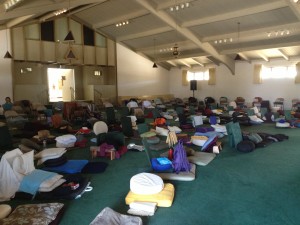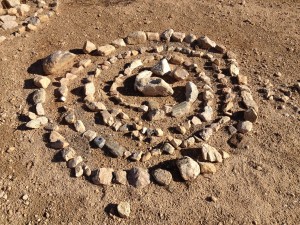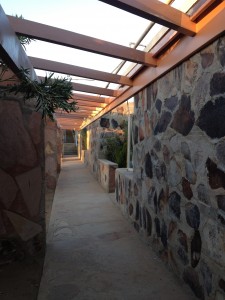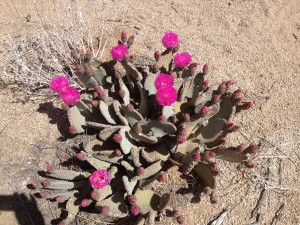Farelong, Oh Crumpleweed
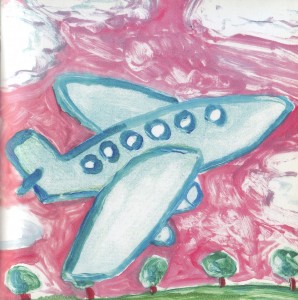 Note: I will be away on retreat until Oct 24, so there will be no new DharmaTown postings until I return.
Note: I will be away on retreat until Oct 24, so there will be no new DharmaTown postings until I return.
***
At the last Dharma Seed KM meeting before my retreat, one of our members (Roberta!) brought home-made muffins (which she often does!) and this time she decorated one of them (for me!) with a “banner” that read:
Farelong, oh Crumpleweed, our friend! We’ll miss you!
This was especially wonderful since it’s a quote from something my teacher, Lila Wheeler, had read in one of the talks we’ve listened to. (You can hear the talk here.)
Here’s the whole quote:
Whenever I part with my kids or my husband, I always try to say something loving because I imagine a car crash or somebody’s heart giving out, and I don’t want my last words to be impatient or distracted. Neither do I want my “I love you’s” to become automatic. So I’ve been trying to come up with ways to say good-bye that are unique, intimate, and genuine.
For several years when my son was young, he used to say to me, “Farelong, oh Crumpleweed, my friend,” whenever he left the house. I have no idea where he got it. Those are words of good-bye I could live with. — Angelina Citrone, from The Sun magazine
***
So Farelong, oh you Crumpleweeds, my DharmaTown friends. I look forward to connecting with you again when I return.
(image from: A Whole World, by Couprie and Louchard)
What To Bring
 I asked my teacher, Lila Wheeler, if she had any advice on what I should bring with me for the 6-week retreat at IMS, and she said, “You mean, like a teddy bear?”
I asked my teacher, Lila Wheeler, if she had any advice on what I should bring with me for the 6-week retreat at IMS, and she said, “You mean, like a teddy bear?”
And I, of course, laughed.
But she said, “I’m not kidding about the teddy bear.”
Turns out, there’s sort of a tradition on these long retreats of people bringing things to help ease the transition, especially things that will make their room feel like “home.”
Lila said she has a special bedspread she likes to bring….and sometimes even a lamp! I’m coming by plane, so there won’t be anything like that.
For now, I think I’ll bring:
* A postcard of the Quan Yin statue that I love to visit at the St. Louis Art Museum
* A little, brass, “Happy Buddha” (round and about the size of a golf ball) that I think is really the image of some Chinese saint, but who cares…in my mind, it’s the Buddha
* The photo that I keep on my alter at home of my first teacher and on-going inspiration, Mirabai Bush
* A string of paper Tibetan prayer flags that’s in my kitchen right now
* Maybe a litte vase that I can put fresh wildflowers in
* The string of beads I made during the DPP to represent the Seven Factors of Enlightenment
* And something handwritten….I’m not sure what…maybe one of the letters I write to myself every year on New Year’s Day???
It feels like there’s something else, but I don’t know what. (I’m a greed type, so it might just be that.)
Hmmm.
I’ll keep you posted.
(image from: A Whole World, by Couprie and Louchard)
What to Pack for the Inner Journey
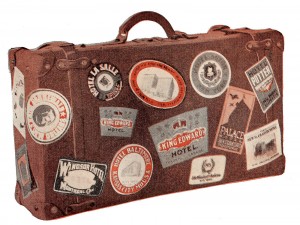 I’ve posted earlier about my upcoming trip to Burma in January. But before that, I’ll be embarking on what could turn out to be an even more ambitious adventure….a 6-week retreat at IMS (Insight Meditation Society) in Barre, Massachusetts, beginning September 10. The longest retreat I’ve been on so far is 10 days. This one will be 43!
I’ve posted earlier about my upcoming trip to Burma in January. But before that, I’ll be embarking on what could turn out to be an even more ambitious adventure….a 6-week retreat at IMS (Insight Meditation Society) in Barre, Massachusetts, beginning September 10. The longest retreat I’ve been on so far is 10 days. This one will be 43!
This is actually just the first half of the annual 3-month retreat at IMS. (Who knows, maybe next year I’ll sit the full 3 months!) The teachers this year will be Joseph Goldstein, Carol Wilson, Guy Armstrong, Winnie Nazarko, Andrea Fella and Bhante Buddharakkhita.
Here’s an excerpt from the teacher’s letter:
“Based on the meditation instructions of Mahasi Sayadaw and supplemented by a range of skillful means, the course will encourage a balanced attitude of relaxation and alertness, and the continuity of practice based on the Buddha’s Four Foundations of Mindfulness. In addition, the meditations on the four Brahma Viharas (lovingkindness, compassion, sympathetic joy and equanimity) will be offered throughout the retreat.
“Ongoing guidance for all participants will include evening discourse five nights each week, guided meditations weekly and daily opportunities for questions about practice. In addition, every meditator will be assigned to a pair of teachers; you will meet individually with one of these teachers every two or three days.”
I’ve been going on retreats for many years now, so this is all fairly standard. Except for this little item, which appears on the accompanying sheet marked Essential Information:
“Laundry is done every two weeks, with the exception of underwear, which is done weekly. Since your laundry will be washed together with that of other yogis, please label all your clothing with a waterproof marker.”
Hmmm. I pretty much always wear black yoga pants when I go on retreat….as does almost everyone else. So I’m wondering: what kind of “waterproof marker” is going to show up on black yoga pants? And how am I going to be able to tell my black yoga pants from the hundred or so other black yoga pants?!
Aware of Awareness
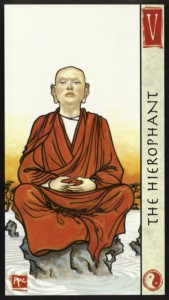 If you’re interested in trying the Dharma Seed Virtual Retreat I wrote about in yesterday’s post, it would be a good idea to listen to Guy Armstrong’s Meditation Instructions, which he gave on the morning after the first talk.
If you’re interested in trying the Dharma Seed Virtual Retreat I wrote about in yesterday’s post, it would be a good idea to listen to Guy Armstrong’s Meditation Instructions, which he gave on the morning after the first talk.
The first talk is available: here. The meditation instructions are: here. The full list of all the retreat talks is: here.
Guy’s instructions run 55 minutes. During the first 15 minutes, he gives very clear…and quite beautiful….guidance for using Awareness itself as an object of meditation. He talks about experiencing Awareness as an open field, as well as knowing it in relation to a chosen object, such as sounds, body sensations or the breath.
The next 30 minutes are silent. (So you can meditate!)
The last 10 minutes are Question & Answer.
Check it out.
(image from: Feng Shui Tarot)
It Starts With Suffering
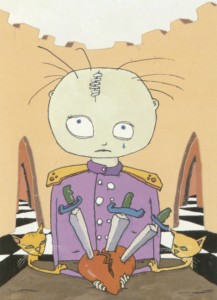 One of my favorite topics at the final DPP retreat was the Twelve Links of Transcendent Dependent Arising. Basically, these links diverge from the rounds of samsara as described in the Twelve Links of Dependent Origination, which start with Ignorance and lead repeatedly to Suffering. But this chain of arising leads AWAY from that endless cycle of suffering….and goes all the way to Liberation!
One of my favorite topics at the final DPP retreat was the Twelve Links of Transcendent Dependent Arising. Basically, these links diverge from the rounds of samsara as described in the Twelve Links of Dependent Origination, which start with Ignorance and lead repeatedly to Suffering. But this chain of arising leads AWAY from that endless cycle of suffering….and goes all the way to Liberation!
The path to liberation starts with suffering (dukkha). Which is good news…because that’s what we’ve got! Things are not the way we want them to be; we don’t get what we want; we have to deal with all kinds of stuff we don’t want; etc. etc. etc.
So we start with suffering. But then we move AWAY from it. By gaining confidence and trust….faith….in what we can see for ourselves through the practices of meditation.
More on that tomorrow.
And then on to the next link, then to the next, one each day until we get to the last — which is total freedom.
Here’s the whole list:
Suffering (dukkha)
Faith (saddha)
Joy (pamojja)
Rapture (piti)
Tranquility (passaddhi)
Happiness (sukha)
Concentration (samadhi)
Knowledge and Vision of Things As They Are (yathabhutananadassana)
Disenchantment (nibbida)
Dispassion (viraga)
Emancipation (vimutti)
Knowledge of Destruction of the Taints (asavakkhaye nana)
(image: Phantasmagoric Theater Tarot)
More Pix
After almost 3 weeks of retreat, I’m still at a bit of a loss for words….so I’ll just post some more pictures.
 Here’s me getting up before dawn to meditate.
Here’s me getting up before dawn to meditate.
 Here’s the room where I had been sleeping so soundly.
Here’s the room where I had been sleeping so soundly.
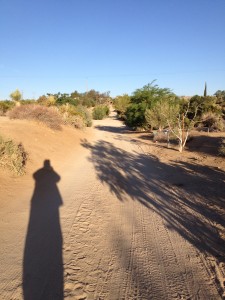 Here’s the path to the meditation hall.
Here’s the path to the meditation hall.
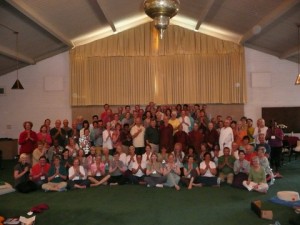 Here’s the whole DPP “class” on the final day of the program.
Here’s the whole DPP “class” on the final day of the program.
Postcards
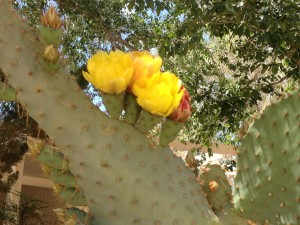 I’m back from the final DDP Retreat and Jack Kornfield’s Annual Spring Retreat, both at Joshua Tree Retreat Center. I have lots to tell…but it’ll have to wait till I get my email taken care of! So I’ll just post a couple of sneak peeks. More to come.
I’m back from the final DDP Retreat and Jack Kornfield’s Annual Spring Retreat, both at Joshua Tree Retreat Center. I have lots to tell…but it’ll have to wait till I get my email taken care of! So I’ll just post a couple of sneak peeks. More to come.
On Retreat Until May 13
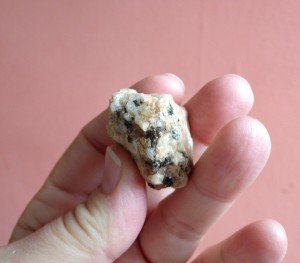 I’m leaving tomorrow morning for the final DPP retreat in Yucca Valley, then staying on to attend Jack Kornfield’s annual Spring Retreat, so I won’t be posting again after until I get back on May 13.
I’m leaving tomorrow morning for the final DPP retreat in Yucca Valley, then staying on to attend Jack Kornfield’s annual Spring Retreat, so I won’t be posting again after until I get back on May 13.
At the first DPP retreat in 2011 (which was also held in Yucca Valley) Phillip Moffitt asked each of us to go out into the desert and find a stone — one that appealed to us for some reason or other — and to bring it back into the meditation hall. We did a little ceremony with them then, which involved placing them, one by one, on a larger stone that was passed around the room, and each of us calling to mind our deepest intention for the 2-year program we’d just to embarked upon.
(I’m not really sure why I chose the stone I did…but I think it was because it had a lot of colors in it — which made it seem complex and worthy of investigation — but mostly, I think, because it sparkled in the sunlight.)
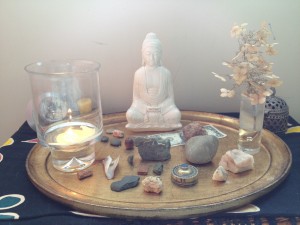 Now the program is ending. And we’ve been asked to bring these same stones back, to be used as part of our closing ceremony. I don’t know what the ceremony will be like. But this stone has been sitting on my home alter all this time, along with a lot of other stones and various things I’ve collected on other retreats and significant occasions.
Now the program is ending. And we’ve been asked to bring these same stones back, to be used as part of our closing ceremony. I don’t know what the ceremony will be like. But this stone has been sitting on my home alter all this time, along with a lot of other stones and various things I’ve collected on other retreats and significant occasions.
I wonder if the ceremony will include bringing the stones back home, or if we’ll leave them out there in the dessert.
Either way, the intention I made that first night will stay with me.
Sit with Jack in Cyberspace
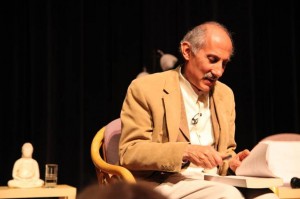 Sitting on retreat with Jack Kornfield is such an inspiring experience…but sadly not everyone can go to Spirit Rock, or Yucca Valley, or wherever Jack is teaching.
Sitting on retreat with Jack Kornfield is such an inspiring experience…but sadly not everyone can go to Spirit Rock, or Yucca Valley, or wherever Jack is teaching.
Until now!
Spirit Rock now offers LIVE webcasting at some of the more popular events, including Jack’s Introduction to Insight Meditation, on Saturday, April 13, 11 am to 7 pm St. Louis time (9 am to 5 pm PST).
This is a traditional Insight Meditation daylong retreat with instructions, silent sitting and walking meditation and dharma talk. Cost is $30. Do it, if you can. It will be so worth it. For more information and to register, click here.
Seat & Feet
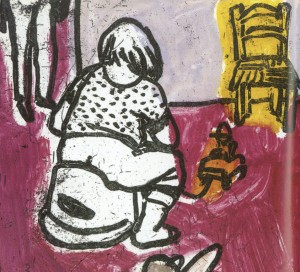 Here’s a tip I brought back from one of Eric Kolvig‘s talks at the Tucson retreat:
Here’s a tip I brought back from one of Eric Kolvig‘s talks at the Tucson retreat:
Periodically throughout the day, especially when things start to escalate, see if you can bring your attention to your “seat” (the sensations of your butt on the chair, if you’re sitting) and/or to your feet. This offers a chance to get out of the whirlwind of whatever’s going on for a second and helps to ground you in the present moment. It doesn’t change anything about what’s going on. Except that it interrupts the habitual reactions we often get hooked into…which, of course, does give us the chance to take a fresh look at the situation and maybe respond more skillfully this time.
Give it a try!
(image: from “A Whole World,” by Couprie and Louchard)

